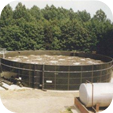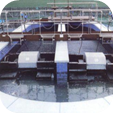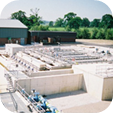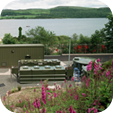BiFAD



 Sewage treatment in the ‘BiFAD’ system is achieved via a fill, aerate and settle / decant function, separated only by time. One tank is used for the treatment, rthereby providing an extremely economical plant that is particularly suited to the treatment of variable flows e.g. military camps and small villages. Construction is simple and may be either a reinforced concrete or steel tank. The latter usually shows considerable cost advantages. The tank is frequently situated above ground so that site excavation costs are minimal. The plant is controlled by 2 level probes and a series of fully adjustable timers, which are used to control the aeration, fill and settle / decant sequences. Aeration is controlled in conjunction with D.O. probes linked to minimum run and stop timers. Surplussing of sludge from the Bifad is also controlled via a timer and surplussing is initiated during the decant cycle. Incoming sewage is mixed and aerated with naturally developed and activated sludge in the tank by means of either mechanical floating aerators or fine bubble diffusers.
Sewage treatment in the ‘BiFAD’ system is achieved via a fill, aerate and settle / decant function, separated only by time. One tank is used for the treatment, rthereby providing an extremely economical plant that is particularly suited to the treatment of variable flows e.g. military camps and small villages. Construction is simple and may be either a reinforced concrete or steel tank. The latter usually shows considerable cost advantages. The tank is frequently situated above ground so that site excavation costs are minimal. The plant is controlled by 2 level probes and a series of fully adjustable timers, which are used to control the aeration, fill and settle / decant sequences. Aeration is controlled in conjunction with D.O. probes linked to minimum run and stop timers. Surplussing of sludge from the Bifad is also controlled via a timer and surplussing is initiated during the decant cycle. Incoming sewage is mixed and aerated with naturally developed and activated sludge in the tank by means of either mechanical floating aerators or fine bubble diffusers.
A typical ‘Bifad’ cycle would include
- Maximum 20 hours aeration of sewage (including 3 hours minimum of tank fill time)
- One hour settlement
- Three hours decanting of final effluent and sludge surplussing
The treatment of the pollution is a two step process; absorption into the sludge mass followed by enzymic oxidation, and conversion in the bacteria cells. Effluent from the Bifad is decanted using either a telescopic valve or a floating arm.
